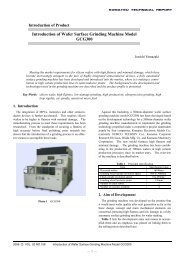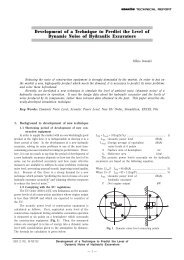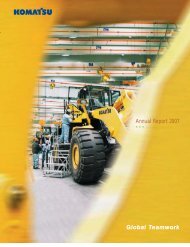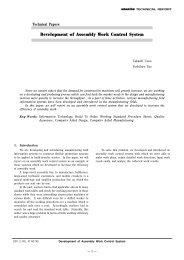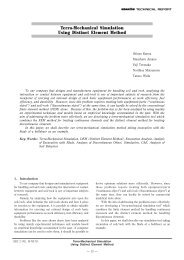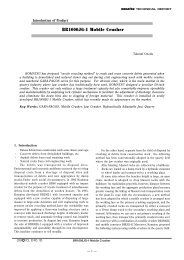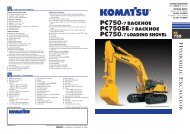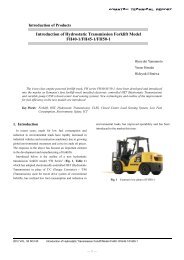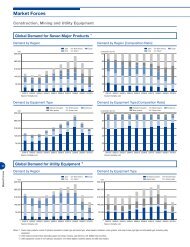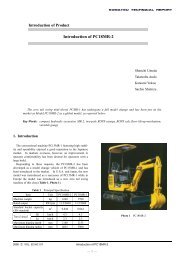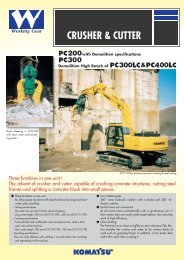Annual Report 2006 - Komatsu
Annual Report 2006 - Komatsu
Annual Report 2006 - Komatsu
Create successful ePaper yourself
Turn your PDF publications into a flip-book with our unique Google optimized e-Paper software.
Notes to Consolidated Financial Statements<br />
<strong>Komatsu</strong> Ltd. and Consolidated Subsidiaries<br />
1. Description of Business, Basis of Financial Statements and Summary of Significant Accounting Policies<br />
Description of Business<br />
<strong>Komatsu</strong> Ltd. (“the Company”) and consolidated subsidiaries<br />
(together “the companies”) primarily manufacture and market<br />
various types of construction and mining equipment throughout<br />
the world. The companies are also engaged in the manufacture<br />
and sale of industrial machinery, and vehicles and electronics<br />
products including semiconductors.<br />
The consolidated net sales of the Company and consolidated<br />
subsidiaries for the year ended March 31, <strong>2006</strong>, consisted of the<br />
following:Construction and mining equipment – 75.9%,<br />
Industrial Machinery, Vehicles and Others – 17.6%, Electronics –<br />
6.5%.<br />
Sales are made principally under the <strong>Komatsu</strong> brand name,<br />
and are almost entirely through sales subsidiaries and sales distributors.<br />
These subsidiaries and distributors are responsible for marketing<br />
and distribution and primarily sell to retail dealers in their<br />
geographical area. Of consolidated net sales for the year ended<br />
March 31, <strong>2006</strong>, 68.9% were generated outside Japan, with<br />
28.3% in the Americas, 14.2% in Europe and CIS, 5.6% in<br />
China, 14.0% in Asia (excluding Japan and China) and Oceania,<br />
and 6.8% in the Middle East and Africa.<br />
The manufacturing operations of the Company and consolidated<br />
subsidiaries are conducted primarily at plants in Japan,<br />
United States, Germany, United Kingdom, Sweden, Indonesia,<br />
Brazil, Italy, China and Taiwan.<br />
Basis of Financial Statements<br />
The accompanying consolidated financial statements are stated<br />
in Japanese yen, the functional currency of the country in which<br />
the Company is incorporated and principally operates. The translation<br />
of Japanese yen amounts into United States dollar<br />
amounts for the year ended March 31, <strong>2006</strong>, is included solely<br />
for the convenience of readers and has been made at the rate of<br />
¥117 to $1, the approximate rate of exchange prevailing at the<br />
Federal Reserve Bank of New York on March 31, <strong>2006</strong>. Such<br />
translation should not be construed as a representation that<br />
Japanese yen amounts could be converted into United States<br />
dollars at the above or any other rate.<br />
The Company and its domestic subsidiaries maintain their<br />
books of account in conformity with accounting principles generally<br />
accepted in Japan, and its foreign subsidiaries generally<br />
maintain their books of account in comformity with those in the<br />
country of their domicile. The accompanying consolidated financial<br />
statements reflect certain adjustments, not recorded in the<br />
companies’ books, to present them in conformity with U.S. generally<br />
accepted accounting principles. These adjustments are made<br />
mainly in connection with accounting for liability for pension and<br />
other retirement benefits, leases, derivative financial instruments,<br />
and recognition of certain accrued expenses. Certain reclassifications<br />
have been made to prior year amounts to conform with current<br />
year presentation.<br />
Summary of Significant Accounting Policies<br />
(1) Consolidation and Investments in Affiliated Companies<br />
The consolidated financial statements include the accounts<br />
of the Company and all of its majority-owned domestic and<br />
foreign subsidiaries, except for certain immaterial subsidiaries.<br />
The accounts of any variable interest entities that must be consolidated<br />
under Financial Accounting Standards Board (“FASB”)<br />
Interpretation No. 46 (revised December 2003) (“FIN 46R”),<br />
“Consolidation of Variable Interest Entities”, because the<br />
Company has been determined to be the primary beneficiary, are<br />
included in the consolidated financial statements.<br />
Investments in 20 to 50% owned affiliated companies whereby<br />
the companies have the ability to exercise significant influence<br />
over the operational and financial policies of a company<br />
are accounted for by the equity method.<br />
(2) Translation of Foreign Currency Accounts<br />
Under the provisions of Statement of Financial Accounting<br />
Standards (“SFAS”) No. 52, “Foreign Currency Translation,” assets<br />
and liabilities are translated at the exchange rates in effect<br />
at each fiscal year-end, and income and expenses are translated<br />
at the average rates of exchange prevailing during each fiscal<br />
year in consolidating the financial statements of overseas<br />
subsidiaries. The resulting translation adjustments are included<br />
as a separate component of accumulated other comprehensive<br />
income (loss) in the accompanying consolidated financial statements.<br />
All foreign currency transaction gains and losses are included<br />
in other income or expenses in the period incurred.<br />
(3) Allowance for Doubtful Trade Receivables<br />
The companies record allowance for doubtful receivables as the<br />
best estimate of the amount of probable credit losses in the<br />
companies' existing receivables. The amount is determined<br />
based on historical experience, credit information of individual<br />
customers, and assessment of overdue receivables. An additional<br />
reserve for individual receivable is recorded when the companies<br />
become aware of a customer's inability to meet its financial<br />
obligations, such as in the case of bankruptcy filings or deterioration<br />
of the customer's business performance. The amount of<br />
estimated credit losses is further adjusted to reflect changes in<br />
customer circumstances.<br />
(4) Inventories<br />
Inventories are stated at the lower of cost or market. The companies<br />
determine cost of work in process and finished products<br />
using the specific identification method based on actual costs accumulated<br />
under a job-order cost system. The cost of finished<br />
parts is determined principally using the first-in first-out method,<br />
with certain immaterial amounts using the last-in first-out<br />
method. Cost of materials and supplies is stated at average cost.<br />
55 <strong>Annual</strong> <strong>Report</strong> <strong>2006</strong>



